
views
- Pick a dry, well-ventilated workspace. Wear safety gear, including a respirator and heat-resistant clothes, to protect yourself from lead dust and molten metal.
- Melt the lead in a cast iron skillet over a flame, or use an electric melting pot. Use a slotted aluminum spoon to remove impurities from the molten lead.
- Transfer the molten lead to a mold, wait 10 minutes, and remove the solidified lead. Clean your workspace, tools, and body thoroughly to prevent lead poisoning.
Preparation & Safety Gear

Pick a dry, well-ventilated workspace, like an open garage. Make sure there are no flammable materials within 8 ft (2.4 m) of where you’ll be melting the lead. If you don’t have a garage, use an isolated outdoor patch of dry dirt, sand, or concrete. Never melt lead indoors due to the risk posed by lead fumes, lead dust, and fire. Avoid working with lead if you’re pregnant or nursing. Keep children, pets, or anyone who is pregnant or nursing out of the area. Lead fumes can be harmful to developing fetuses, infants, and small children.
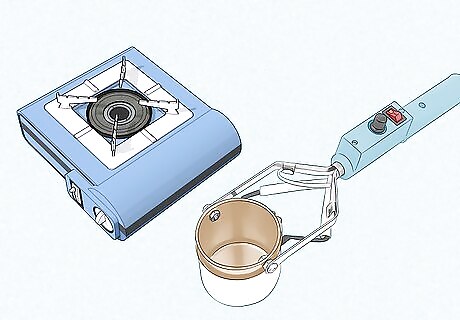
Choose a gas-powered heat source, or use an electric melting pot. Use a handheld blowtorch or propane burner for gas-powered heat. Or you can use an electric melting pot (also known as a melting furnace), which is specifically designed for melting metals like lead. The melting point of lead is 621 °F (327 °C), so you’ll need a powerful yet safe heat source to do the job. You can buy a handheld kitchen blowtorch for $15-30. These are relatively safe and easy to use, but you’ll have to hold the flame close to the lead to melt it, and you’ll only have one free hand for other tasks. A propane burner will cost around $30-60. Many come with built-in stands where you can place the container for melting the lead. You can purchase an electric melting pot (a.k.a., a melting furnace) for $50-100. While they’re the priciest option, they pose a lower fire risk since they don’t use an open flame.
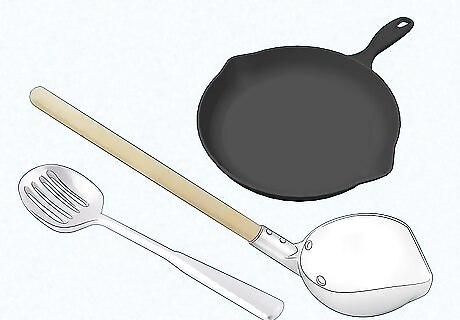
Buy a cast iron skillet, slotted aluminum spoon, and aluminum ladle. Only use these items for melting lead—never for cooking or preparing food. Lead is highly poisonous, so once these items have been used to melt lead, they shouldn’t come anywhere near your kitchen. For safety, store these items in a garage, toolshed, or utility closet with other tools. Label them “For lead only!” to avoid confusion. Never keep them in your kitchen, and never store them with any skillets or cooking utensils used for food.
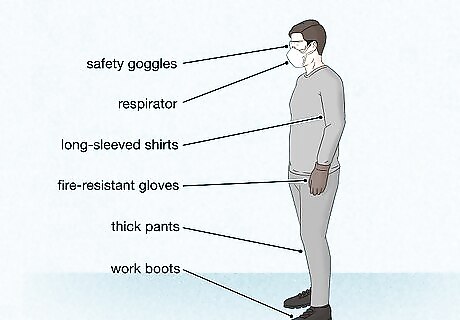
Put on a respirator, safety goggles, and fire-resistant clothing. Wear fire-resistant gloves, work boots, thick, long-sleeved shirts, and thick pants. These items will protect you from fire, extreme heat, molten metal, and lead dust. Choose a particulate respirator rated for lead dust. Use safety goggles or a welder’s mask. Wear aluminized gloves rated for high temperatures. Put on a fire-resistant shirt and pants. You can also wear a fireproof apron on top. If you have long hair, tie it up and use a hair net. Keep a fire extinguisher nearby in case something catches fire unexpectedly.
Melting the Lead
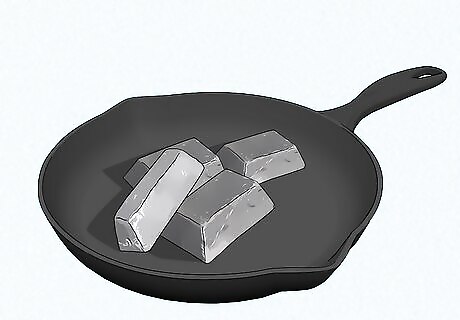
Add pieces of lead to your cast iron skillet or electric melting pot. If you want to melt a particular amount of lead, add that amount plus another 20%. For instance, if you want to melt 1 kg (2.2 lb), add 1.2 kg (2.6 lb) of lead scrap. This compensates for any material lost due to impurities, or from lead getting stuck to your container or tools. Avoid filling your container more than 75% full. This prevents lead from spilling over the sides when you stir it. If you want to melt more lead at once, use a larger skillet or melting pot.

Apply direct heat until the lead is fully melted. If you’re using a handheld torch, wave the flame back and forth over the lead in your skillet. For a propane burner, heat your skillet using the highest flame setting. For an electric melting pot, plug it in and set it to a temperature of 700-800°F (370-425°C). Your lead will take 5-10 minutes to fully melt. Melting time can vary based on the heat applied, impurities in the lead, ambient temperature, and other factors.
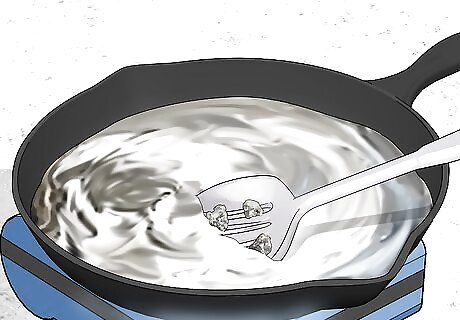
Use your slotted aluminum spoon to skim off floating impurities. As your lead melts, these impurities—called “dross”—will appear as solid bits of material floating on the surface. Carefully skim the dross and put the pieces in a separate aluminum container, like a coffee can. If possible, use an aluminum can with a lid. When you’re done, you can close the lid to prevent lead dust from spreading from the dried dross. Make sure the spoon and discard vessel are completely dry before using them. Molten lead can cause water droplets to vaporize instantly, potentially spraying the molten lead all over you.
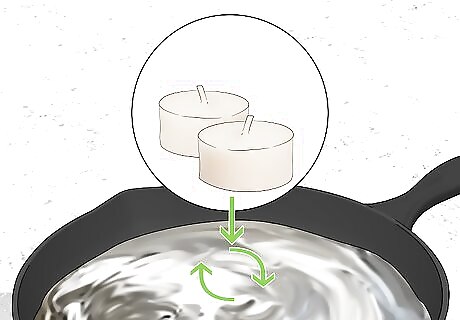
Stir in 1-2 tea wax candles to purify the lead. This is optional, in case you want your lead to be extremely pure. Stir in the molten wax until smoke and flames rise from the molten lead. Any impurities in the molten lead will stick to the wax and float to the surface as “dross.” Continue stirring for another 1-2 minutes until the smoke and flames die down, then use your slotted spoon to remove the skim the dross off the surface of the molten lead. If don’t need your lead to be extra pure, you can skip this step. Use caution when stirring over the flame. Watch your surroundings to prevent the fire from spreading beyond your container. If something else catches fire, put it out with your fire extinguisher. For extra purification, stir in a second tea light candle after using the spoon to skim off and discard the dross produced by the first candle.
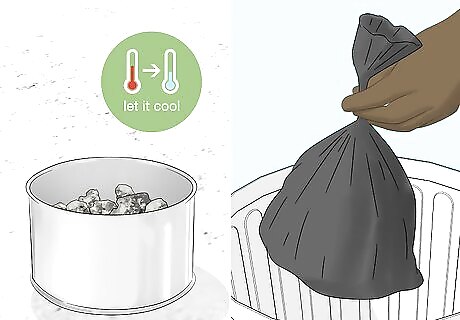
Throw the discard vessel away in an outdoor trash can. Allow the dross to cool inside the discard vessel for 20-30 minutes, or until the vessel is cool to the touch. Once the vessel has cooled, put in a trash bag and place it with your outdoor garbage, or in a dumpster where it can be collected with other trash. The lead-contaminated material in your discard vessel is considered hazardous waste. Avoid bringing the container inside your home, and never dispose of it in your indoor garbage can. Wear your safety gear when handling the vessel until it has cooled down.
Pouring and Unmolding the Lead
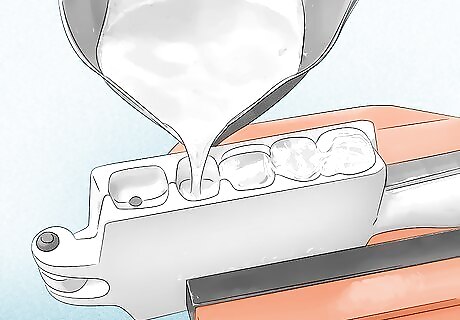
Pour your molten lead into a mold, or use a ladle to transfer it. Turn off the heat source just before you pour, since the lead will cool down quickly and resolidify. If your cast iron skillet has a spout built into its lip, pour the metal directly into your chosen mold. Or if you prefer, use your aluminum ladle to scoop the molten lead into the mold. Swirl the mold gently after adding the metal to help any air bubbles escape. Make sure the mold is completely dry before putting any lead into it. You can use pre-made molds to cast items like fishing sinkers. You can also use an aluminum muffin pan to make ingots (puck-shaped pieces of lead). Don’t place your hands (or any other body part) directly over the opening of the mold. Hot gasses from the molten lead could burn you, even if you’re wearing heat-resistant gloves.
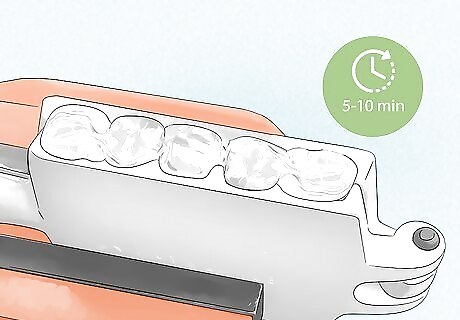
Allow the lead to cool in the mold for 5-10 minutes. The lead will likely solidify within 2-3 minutes. However, it’s best to let the lead cool for 5-10 minutes so that it’s safer to handle. While you’re waiting for the lead to cool, begin cleaning up by closing the valve on your propane tank, unplugging your metal melting pot, or closing and disconnecting the gas source for your blowtorch. Keep your safety gear on for now, including your goggles, gloves, and respirator.

Remove the lead from the mold after 5-10 minutes. Keep your gloves on, even if the mold is cool to the touch, because the lead may still be hot enough to burn you. Lead does not adhere well to other metals, so you’ll have no problem opening the mold and removing the lead. If you’re using an aluminum muffin pan, turn the pan over and tap it against a solid surface to free the lead ingots. For a 2-piece mold used to make things like fishing sinkers, unscrew the wingnuts on the bolts that hold the 2 halves together. The cast lead will pop out.

Clean your body, clothes, tools, and workspace immediately. Lead is extremely poisonous, so you must decontaminate yourself and your environment right away. Use a wet-dry vacuum fitted with a HEPA filter to suck up any lead dust that has accumulated on your tools or workspace. Remove your clothes in a garage or somewhere else outside your home. Bag them up and wash them separately from the rest of your laundry. Take a shower and wash your hair and body thoroughly. Lead exposure can cause permanent brain damage in children and unborn fetuses. Avoid working with lead if you’re pregnant or nursing. Never allow children or anyone who is pregnant to use your lead-contaminated tools or come near your workspace before you clean it. Your cleaned tools, clothes, and safety gear may still contain traces of lead. Store them in a sealed container in a garage or outdoor shed, away from pets and children. Breathing in lead dust can be harmful. Wear your respirator and goggles while cleaning your workplace and tools. Use a chisel or flat-head screwdriver to scrape off any molten lead that spilled and hardened on the floor of your workspace. Clean every surface of your workspace thoroughly, and wash your body right away. Don’t wait until later in the day.

















Comments
0 comment